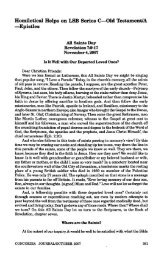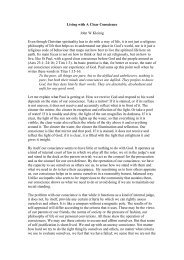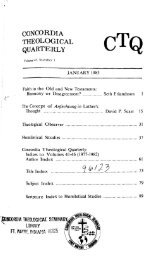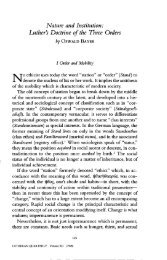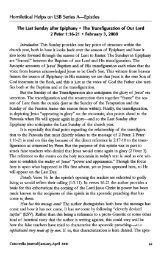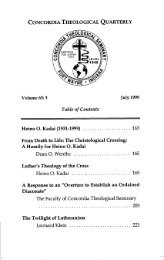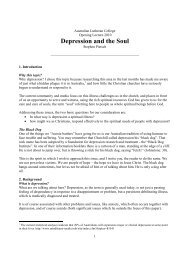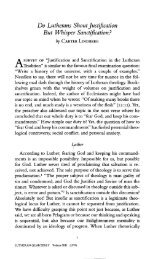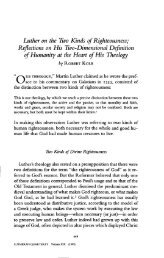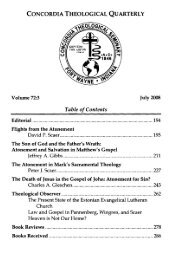Gustaf Wingren's Confession of the Doctrine of Creation for an ...
Gustaf Wingren's Confession of the Doctrine of Creation for an ...
Gustaf Wingren's Confession of the Doctrine of Creation for an ...
You also want an ePaper? Increase the reach of your titles
YUMPU automatically turns print PDFs into web optimized ePapers that Google loves.
<strong>Gustaf</strong> Wingren’s <strong>Confession</strong> <strong>of</strong> <strong>the</strong> <strong>Doctrine</strong> <strong>of</strong> <strong>Creation</strong><br />
<strong>for</strong> <strong>an</strong> Underst<strong>an</strong>ding <strong>of</strong> Vocation <strong>an</strong>d S<strong>an</strong>ctification<br />
ERIC R. ANDRAE<br />
<br />
“IN THE BEGINNING ...”<br />
T<br />
HAT IS WHERE THIS INVESTIGATION INTO <strong>Gustaf</strong> Wingren’s<br />
doctrine <strong>of</strong> creation, called by Douglas Jay “his <strong>Creation</strong><br />
Faith,”¹ rightly commences. Wingren writes, “my interests<br />
from <strong>the</strong> very beginning <strong>of</strong> my <strong>the</strong>ological studies were concerned<br />
with <strong>the</strong> doctrine <strong>of</strong> creation <strong>an</strong>d <strong>the</strong> first article.”² It is appropriate<br />
to look at <strong>an</strong>y aspect <strong>of</strong> Wingren’s <strong>the</strong>ology chronologically,<br />
grounded as it is on <strong>the</strong> order <strong>of</strong> God’s acts in <strong>the</strong> history <strong>of</strong><br />
m<strong>an</strong>kind. According to Wingren, “The tripartite Creed . . .<br />
arr<strong>an</strong>ges <strong>the</strong>se wonderful works <strong>of</strong> God in <strong>the</strong> order which God<br />
chooses when he does <strong>the</strong>m.”³ As such, I will examine Wingren’s<br />
thought on creation as it unfolds in some <strong>of</strong> his major writings,<br />
selected from different periods.<br />
This essay examines <strong>the</strong> development <strong>an</strong>d consistency in<br />
Wingren’s thought. The selection <strong>of</strong> “major” material is, gr<strong>an</strong>ted,<br />
subjective. It is also difficult, because, as Wingren admits, his<br />
“recurring <strong>the</strong>me [is] <strong>the</strong> first article <strong>of</strong> faith”⁴ from <strong>the</strong> Apostles’<br />
Creed: <strong>the</strong> doctrine <strong>of</strong> creation. As such, his “Theology <strong>of</strong><br />
<strong>Creation</strong>-Faith”⁵ is <strong>the</strong> foundation <strong>for</strong> all that he has written.<br />
None<strong>the</strong>less, I have decided to work mainly with those articles<br />
<strong>an</strong>d books which deal more or less directly with <strong>the</strong> doctrine <strong>of</strong><br />
creation since <strong>the</strong> task at h<strong>an</strong>d is <strong>Gustaf</strong> Wingren’s doctrine <strong>of</strong><br />
creation, not <strong>Gustaf</strong> Wingren’s writings reviewed. The task to<br />
which we address ourselves in this investigation <strong>of</strong> Wingren’s<br />
doctrine <strong>of</strong> creation is historical in that its only aim is underst<strong>an</strong>ding<br />
<strong>Gustaf</strong> Wingren’s thought on one special point, within<br />
<strong>the</strong> confines <strong>of</strong> a <strong>the</strong>ological journal essay.⁶ Within this area <strong>of</strong><br />
“major” writings, some will receive considerably more attention<br />
th<strong>an</strong> o<strong>the</strong>rs (e.g., The Living Word, Lu<strong>the</strong>r on Vocation) <strong>for</strong> various<br />
reasons—length <strong>of</strong> work, “creation” content, Wingren’s own<br />
assessment <strong>of</strong> his writings, <strong>the</strong>ological impact, my assessment,<br />
etc. —which will be made apparent later. It is tempting to concentrate<br />
mostly on Wingren’s The Living Word, Theology in<br />
Conflict, <strong>Creation</strong> <strong>an</strong>d Law, <strong>an</strong>d Gospel <strong>an</strong>d <strong>the</strong> Church, since <strong>the</strong>y<br />
are, as <strong>the</strong>ir author says, a “series <strong>of</strong> four related books.”⁷<br />
However, doing this would exclude <strong>the</strong> influential Vocation,“one<br />
<strong>of</strong> <strong>the</strong> outst<strong>an</strong>ding works <strong>of</strong> present-day Swedish <strong>the</strong>ology [<strong>an</strong>d]<br />
perhaps <strong>the</strong> best introduction into <strong>the</strong> <strong>the</strong>ology <strong>of</strong> <strong>the</strong><br />
Re<strong>for</strong>mer,”⁸ as well as The Flight from <strong>Creation</strong>, <strong>the</strong> author’s<br />
extremely helpful review <strong>of</strong> his first article work <strong>an</strong>d its implica-<br />
ERIC R. ANDRAE is pastor <strong>of</strong> First Trinity Lu<strong>the</strong>r<strong>an</strong> Church, Pittsburgh,<br />
Pennsylv<strong>an</strong>ia.<br />
29<br />
tions. I was greatly aided in my choices by Henry V<strong>an</strong>der Goot’s<br />
bibliography.⁹<br />
CREATION: LUTHER ON VOCATION<br />
A brief overview <strong>of</strong> Wingren’s very early work may be helpful.<br />
Wingren was born in 1910 in Tryserum, Sweden; taught at Lund<br />
(associate pr<strong>of</strong>essor 1942), Aabo, <strong>an</strong>d Basel; <strong>an</strong>d succeeded Anders<br />
Nygren as chair <strong>of</strong> systematic <strong>the</strong>ology at Lund 1951–1977,<br />
one <strong>of</strong> only two pr<strong>of</strong>essorships <strong>of</strong> systematic <strong>the</strong>ology available<br />
at state universities in <strong>the</strong> entire country. Wingren thus<br />
attained to one <strong>of</strong> <strong>the</strong> most import<strong>an</strong>t posts in Swedish<br />
Lu<strong>the</strong>r<strong>an</strong> state-church culture <strong>an</strong>d life.<br />
He matriculated at <strong>the</strong> University <strong>of</strong> Lund in 1929. In 1936, at <strong>the</strong><br />
tender age <strong>of</strong> twenty-six, he was first published: “Marcions kristendomstolkning”<br />
(“Marcion’s Underst<strong>an</strong>ding <strong>of</strong> Christi<strong>an</strong>ity”¹⁰ ) in<br />
Svensk Teologisk Kvartalskrift (STK). Here Wingren established<br />
early his interest in <strong>an</strong>d defense <strong>of</strong> <strong>the</strong> Old Testament,¹¹ specifically,<br />
creation. In 1940, sections <strong>of</strong> his licentiate’s <strong>the</strong>sis, subtitled<br />
“Studies in <strong>the</strong> area <strong>of</strong> creation,” were published, yet again in STK:<br />
“Skapelsen, Lagen och Inkarnationen Enligt Ireneus” (“<strong>Creation</strong>,<br />
Law <strong>an</strong>d Incarnation According to Irenaeus”) <strong>an</strong>d “Frälsningens<br />
Gud Såsom Skapare och Domare” (“Salvation’s God as Creator<br />
<strong>an</strong>d Judge”).¹²<br />
Being surrounded at Lund by a number <strong>of</strong> Lu<strong>the</strong>r scholars,<br />
Wingren was encouraged to concentrate on <strong>the</strong> Re<strong>for</strong>mer <strong>for</strong> his<br />
doctoral dissertation. Wingren comments:“But it was still <strong>the</strong> idea<br />
<strong>of</strong> creation that I w<strong>an</strong>ted to deal with. It was <strong>the</strong> given assumption<br />
<strong>for</strong> all my work. The point on which I fastened finally was Lu<strong>the</strong>r’s<br />
doctrine <strong>of</strong> vocation, that is, <strong>of</strong> everyday life <strong>an</strong>d occupations as<br />
<strong>the</strong> place <strong>for</strong> <strong>the</strong> Christi<strong>an</strong> to serve his neighbor. Underlying <strong>the</strong><br />
whole <strong>of</strong> Lu<strong>the</strong>r’s argument is <strong>the</strong> conviction that God is <strong>the</strong><br />
Creator who is still creating life <strong>an</strong>d who, in doing so, uses intercourse<br />
between m<strong>an</strong> <strong>an</strong>d wom<strong>an</strong>, <strong>the</strong> act <strong>of</strong> birth, suckling one’s<br />
young, seedtime <strong>an</strong>d harvest, <strong>the</strong> everyday round.”¹³<br />
As such, Lu<strong>the</strong>rs Lära Om Kallelsen was published in 1942<br />
(Lu<strong>the</strong>r’s <strong>Doctrine</strong> <strong>of</strong> <strong>the</strong> Calling, published in 1947 as Lu<strong>the</strong>r on<br />
Vocation). The “idea <strong>of</strong> creation” permeates what may be<br />
Wingren’s most import<strong>an</strong>t <strong>an</strong>d outst<strong>an</strong>ding work. I shall address<br />
<strong>an</strong>d summarize some specific areas <strong>of</strong> Vocation in which this idea<br />
is present. I will le<strong>an</strong> heavily on Wingren’s Concept. Written twenty-six<br />
years after Vocation, <strong>the</strong> article is <strong>an</strong> excellent summary, by<br />
Wingren himself, <strong>of</strong> his <strong>an</strong>d Lu<strong>the</strong>r’s view on vocation. It clearly
30 LOGIA<br />
shows how Wingren relates vocation, <strong>an</strong>d much else, to <strong>the</strong> doctrine<br />
<strong>of</strong> creation. It is very helpful <strong>an</strong>d insightful.<br />
First, however, we need to relate four fundamental points which<br />
undergird Wingren’s <strong>the</strong>ology throughout Vocation. These four<br />
points are: belief in <strong>the</strong> Creator-God whose creative work is not<br />
finished; <strong>the</strong> struggle between God <strong>an</strong>d Devil is <strong>an</strong> ongoing one,<br />
even at <strong>the</strong> present; eschatalogical outlook: we are not yet at <strong>the</strong><br />
end but wait <strong>for</strong> <strong>the</strong> resurrection from <strong>the</strong> dead; Christ is in us<br />
now through <strong>the</strong> me<strong>an</strong>s <strong>of</strong> grace, effecting death <strong>an</strong>d resurrection<br />
which is everlasting life.¹⁴<br />
Wingren fights against <strong>the</strong> “<strong>the</strong>ology<br />
[which] was aimed at showing <strong>the</strong> gulf,<br />
<strong>the</strong> discontinuity between Christi<strong>an</strong><br />
faith <strong>an</strong>d hum<strong>an</strong> life in general.”<br />
nb<br />
Wingren limits his study by saying: “Here we are inquiring only<br />
into Lu<strong>the</strong>r’s conception <strong>of</strong> earthly work, not vocation in <strong>an</strong>y<br />
o<strong>the</strong>r sense.”¹⁵ I would posit that Lu<strong>the</strong>r’s conception is also<br />
Wingren’s conception. Through my reading <strong>of</strong> Wingren’s books<br />
<strong>an</strong>d articles it has become apparent to me that Wingren le<strong>an</strong>s<br />
heavily on Lu<strong>the</strong>r. Wingren’s <strong>the</strong>ology, <strong>an</strong>d specifically his doctrine<br />
<strong>of</strong> creation, is greatly shaped <strong>an</strong>d influenced by <strong>the</strong><br />
Re<strong>for</strong>mer. Wingren maintains that “Lu<strong>the</strong>r is <strong>the</strong> biblical interpreter<br />
<strong>for</strong> <strong>the</strong> whole church. Lu<strong>the</strong>r is doctor ecclesiae universalis.”¹⁶<br />
He says: “Everything that brings me into relation with<br />
o<strong>the</strong>r people, everything that makes my actions events in o<strong>the</strong>r<br />
people’s lives is contained in ‘vocation.’”¹⁷ In <strong>the</strong> first section,<br />
“Earth <strong>an</strong>d Heaven,” he explores <strong>an</strong>d astutely explains Lu<strong>the</strong>r’s<br />
<strong>the</strong>ory <strong>of</strong> <strong>the</strong> two realms: <strong>the</strong> heavenly kingdom (gospel: <strong>for</strong>giveness<br />
<strong>of</strong> sin) <strong>an</strong>d <strong>the</strong> earthly kingdom (Law: “God’s providence,<br />
protection, <strong>an</strong>d direction in material matters”).¹⁸ Both are <strong>of</strong> God,<br />
created by him.¹⁹ It is in <strong>the</strong> earthly kingdom that God as Creator<br />
gives stations to all.²⁰<br />
Wingren fights against <strong>the</strong> “<strong>the</strong>ology [which] was aimed at<br />
showing <strong>the</strong> gulf, <strong>the</strong> discontinuity between Christi<strong>an</strong> faith <strong>an</strong>d<br />
hum<strong>an</strong> life in general.”²¹ As Gerhard Forde points out, <strong>for</strong><br />
Wingren “<strong>Creation</strong> comprises <strong>the</strong> fact that we are given <strong>the</strong> gift <strong>of</strong><br />
life <strong>an</strong>d in this gift <strong>of</strong> life we are related to God. <strong>Creation</strong> is not<br />
merely <strong>an</strong> act <strong>of</strong> God in <strong>the</strong> past about which m<strong>an</strong> may or may not<br />
know. It is <strong>an</strong> immediate²² relationship given in <strong>the</strong> present, <strong>an</strong><br />
ongoing activity <strong>of</strong> God. To live me<strong>an</strong>s to be related to God, to be<br />
dependent on him.”²³ These thoughts <strong>for</strong>m <strong>the</strong> foundation <strong>of</strong><br />
Vocation, because “Lu<strong>the</strong>r puts worldly labor be<strong>for</strong>e <strong>the</strong> life <strong>of</strong> <strong>the</strong><br />
cloister <strong>an</strong>d celibacy, [<strong>an</strong>d] belief in creation plays <strong>an</strong> import<strong>an</strong>t<br />
part in [his] argument.”²⁴ “The belief in God as creating at <strong>the</strong><br />
present time”²⁵ is key to underst<strong>an</strong>ding Wingren’s <strong>the</strong>ology <strong>an</strong>d<br />
Vocation. God is Creator <strong>an</strong>d creating.²⁶<br />
Thus God creates through m<strong>an</strong>. God serves neighbor through<br />
m<strong>an</strong> (larvae Dei)²⁷ <strong>an</strong>d thus preserves creation against <strong>the</strong><br />
destroyer, <strong>the</strong> devil.²⁸ God created us to live a life <strong>of</strong> love: <strong>the</strong><br />
Christi<strong>an</strong> serves all <strong>of</strong> God’s creation, even<br />
“<strong>the</strong> worst rogues <strong>an</strong>d rascals on earth.” [Lu<strong>the</strong>r]. This is a<br />
pattern <strong>for</strong> Christi<strong>an</strong> love, which must be willing to be misused,<br />
<strong>an</strong>d to be a “lost love” Just as God scatters o<strong>the</strong>r gifts,<br />
so he also scatters this creation <strong>of</strong> his, <strong>for</strong> Christi<strong>an</strong> love itself<br />
is <strong>the</strong> creation <strong>of</strong> God’s Spirit.<br />
Even <strong>the</strong> <strong>of</strong>fice through which God does this is created by him:<br />
“[Lu<strong>the</strong>r:] ‘God gives you <strong>of</strong>fice that you may serve’.” This God<br />
does ex nihilo: <strong>for</strong> without him, m<strong>an</strong> is helpless <strong>an</strong>d dead.“It is just<br />
in m<strong>an</strong>’s need, in times <strong>an</strong>d occasions which look hopeless, that<br />
God out <strong>of</strong> such helplessness, out <strong>of</strong> ‘nothing,’ creates something<br />
new.” Even so, m<strong>an</strong> suffers under vocation’s lowly cross. God’s creation<br />
“out <strong>of</strong> nothing” is exemplified best by <strong>the</strong> Cross: “he who<br />
was despised by <strong>the</strong> world showed himself a true Creator, one who<br />
makes his costliest work out <strong>of</strong> that which is nothing.”²⁹<br />
So, <strong>the</strong> Creator is not merely concerned with <strong>the</strong> beginning <strong>of</strong><br />
<strong>the</strong> world. He is <strong>the</strong> creator <strong>of</strong> “me <strong>an</strong>d all that exists” <strong>an</strong>d he “provides<br />
me daily <strong>an</strong>d abund<strong>an</strong>tly with all <strong>the</strong> necessities <strong>of</strong> life” (SC<br />
II:2). These are concrete acts <strong>of</strong> God as Creator. M<strong>an</strong> is completely<br />
dependent on <strong>the</strong> active h<strong>an</strong>d <strong>of</strong> God <strong>for</strong> life; if he draws it away,<br />
we die. All creatures (created beings), <strong>an</strong>d thus even vocation, fall<br />
under <strong>the</strong> law in God’s kingdom <strong>of</strong> <strong>the</strong> left.<br />
The world is independent in relation to <strong>the</strong> church <strong>an</strong>d to<br />
<strong>the</strong> preaching <strong>of</strong> <strong>the</strong> gospel, but it is not independent in relation<br />
to God. On <strong>the</strong> contrary: in this very world God acts<br />
<strong>an</strong>ew as <strong>the</strong> Creator.³⁰<br />
As such, God does not pull away, but gives occupations which<br />
continue <strong>the</strong> work <strong>of</strong> creation <strong>an</strong>d sustain life: in fields, barns,<br />
mills, factories, board rooms.<br />
Also, through <strong>the</strong> sexual act, we are actually pro-creators with<br />
God. We even have dominion over creation.<br />
Lu<strong>the</strong>r asks how m<strong>an</strong> c<strong>an</strong> have dominion . ..,as <strong>the</strong> biblical<br />
account <strong>of</strong> creation says he does. His <strong>an</strong>swer is that we c<strong>an</strong><br />
make use <strong>of</strong> things in <strong>the</strong> now. We c<strong>an</strong> only wait <strong>for</strong> <strong>the</strong><br />
future; but right where <strong>the</strong> future becomes <strong>the</strong> present, we<br />
c<strong>an</strong> act . . . in <strong>the</strong> interest <strong>of</strong> service to . . . neighbor.<br />
Yet, only God controls time. He sets <strong>the</strong> hour <strong>for</strong> proper action.<br />
“God has his purpose <strong>for</strong> every hour, <strong>an</strong>d his direction is const<strong>an</strong>t,<br />
<strong>for</strong> we c<strong>an</strong> never free ourselves from our neighbor <strong>an</strong>d<br />
our vocation.”³¹<br />
Just as we c<strong>an</strong>not underst<strong>an</strong>d creation aright if we limit it to <strong>the</strong><br />
past, so it is with <strong>the</strong> fall into sin. The devil, <strong>the</strong> destroyer, is at<br />
work now, too. Thus, m<strong>an</strong> is a battlefield upon which <strong>the</strong> devil<br />
<strong>an</strong>d God wage war. The Creator even uses evil <strong>for</strong> his purposes: <strong>for</strong><br />
example, <strong>the</strong> self-seeking businessm<strong>an</strong> is greedy, but thus produces<br />
good products <strong>for</strong> customers. God uses me<strong>an</strong>s to accomplish<br />
his purposes.<br />
When Lu<strong>the</strong>r talks about “equity”³² or about “heroic<br />
men”³³ . . . as <strong>the</strong> me<strong>an</strong>s by which God, creating afresh,
GUSTAF WINGREN’S CONFESSION OF THE DOCTRINE OF CREATION . . . 31<br />
“breaks through <strong>the</strong> law,” <strong>the</strong>n this statement is a testimony<br />
to his dual view <strong>of</strong> <strong>the</strong> natural <strong>an</strong>d <strong>the</strong> Christi<strong>an</strong>. For <strong>of</strong> <strong>the</strong><br />
Christi<strong>an</strong>’s love, too, he says: it “rises above all laws,” “it<br />
breaks through <strong>the</strong> law.”And in both cases <strong>the</strong> breakthrough,<br />
<strong>the</strong> new creation is <strong>the</strong> result <strong>of</strong> a struggle going on. A static<br />
system without <strong>an</strong>y ch<strong>an</strong>ges is quickly occupied by demonic<br />
powers.³⁴ God must const<strong>an</strong>tly do new things in order to<br />
maintain his created world.³⁵<br />
Such eruptions <strong>an</strong>d fresh beginnings are characteristic <strong>of</strong><br />
Lu<strong>the</strong>r’s belief on creation, <strong>for</strong> <strong>the</strong> fact that God creates<br />
implies <strong>for</strong> Lu<strong>the</strong>r something that goes on ceaselessly, “to<br />
create is always to do something new” (creare est semper<br />
novum facere).³⁶<br />
God’s love takes creative <strong>for</strong>m. God creates: in <strong>the</strong> face <strong>of</strong> conflict,<br />
he creates life.<br />
Central to all <strong>the</strong>ology is Christ’s death <strong>an</strong>d resurrection.<br />
Through his baptism, <strong>the</strong> Christi<strong>an</strong> lives daily in death <strong>an</strong>d resurrection.<br />
This resurrection is “<strong>the</strong> new creation.” Sin, even <strong>the</strong> cross<br />
<strong>of</strong> Christi<strong>an</strong> suffering also borne in <strong>an</strong>d through vocation, is<br />
death. Eternal life comes <strong>for</strong>th from daily sorrow <strong>an</strong>d repent<strong>an</strong>ce<br />
(SC IV). The gospel is regenerative. However, it is “not necessary<br />
<strong>for</strong> <strong>the</strong> preservation <strong>of</strong> earthly life.”³⁷ “God <strong>the</strong> Creator acts<br />
through both <strong>the</strong> talent given in natural birth <strong>an</strong>d <strong>the</strong> love <strong>of</strong> <strong>the</strong><br />
new m<strong>an</strong> given by new birth in <strong>the</strong> Word.”³⁸<br />
Eternal life is not separate from earthly life. In his earthly life,<br />
<strong>the</strong> Christi<strong>an</strong> is const<strong>an</strong>tly surrounded by God’s creation. “Round<br />
about him are his fellow-men, whom, according to God’s comm<strong>an</strong>dment,<br />
he shall serve. The worldly acts which provide my fellow-m<strong>an</strong><br />
with his livelihood are acts <strong>of</strong> Christi<strong>an</strong> love <strong>an</strong>d at <strong>the</strong><br />
same time <strong>the</strong>y mould me in Christ’s image, through death <strong>an</strong>d<br />
resurrection to eternal life.”³⁹ Wingren sees this as a converging<br />
point in Lu<strong>the</strong>r’s <strong>the</strong>ology. Certainly it is connected to <strong>the</strong> two<br />
realms, law <strong>an</strong>d gospel, death <strong>an</strong>d resurrection, even baptism.<br />
“The Christi<strong>an</strong> is crucified by <strong>the</strong> law in his vocation, under <strong>the</strong><br />
earthly government; <strong>an</strong>d he arises through <strong>the</strong> gospel, in <strong>the</strong><br />
church under <strong>the</strong> spiritual government.” But “Baptism is . . . completely<br />
only fulfilled in death.” Then m<strong>an</strong>’s position as battlefield<br />
between God <strong>an</strong>d <strong>the</strong> devil is over. “Then m<strong>an</strong>’s struggle is at <strong>an</strong><br />
end.”⁴⁰<br />
CREATION: THE LIVING WORD<br />
Wingren’s creation-faith remained <strong>the</strong> foundation <strong>for</strong> works subsequent<br />
to Vocation. Continuing work on his licentiate’s <strong>the</strong>sis<br />
resulted in <strong>the</strong> publication <strong>of</strong> Människ<strong>an</strong> och inkarnationen ⁴¹ Its<br />
focus is creation <strong>an</strong>d law. He wishes to establish a<br />
mediating position between <strong>the</strong> complete rejection <strong>of</strong> socalled<br />
“natural <strong>the</strong>ology” m<strong>an</strong>ifested in <strong>the</strong> writings <strong>of</strong> Karl<br />
Barth <strong>an</strong>d <strong>the</strong> now defunct ‘philosophy <strong>of</strong> religion’ approach<br />
which sees Christi<strong>an</strong>ity merely as <strong>the</strong> climax <strong>of</strong> all <strong>an</strong>thropocentric<br />
religions.⁴²<br />
Wingren examines closely <strong>the</strong> doctrine <strong>of</strong> recapitulation, within<br />
<strong>the</strong> framework <strong>of</strong> Irenaeus’s <strong>an</strong>thropology over <strong>an</strong>d against <strong>the</strong><br />
Gnostics. The Old <strong>an</strong>d <strong>the</strong> New Testaments serve as <strong>the</strong> unified<br />
basis <strong>for</strong> <strong>the</strong> doctrine <strong>of</strong> m<strong>an</strong>, in which creation <strong>an</strong>d incarnation<br />
restore m<strong>an</strong> to <strong>the</strong> place he occupied in <strong>the</strong> Creator’s intention:<br />
recapitulatio.⁴³<br />
Predik<strong>an</strong> [The Sermon]⁴⁴ appeared in 1949. The book is not one<br />
dealing with homiletical methods, but ra<strong>the</strong>r it is a<br />
systematic/dogmatic work in that it “represents Wingren’s entire<br />
<strong>the</strong>ological program”⁴⁵ as <strong>the</strong> backbone <strong>of</strong> preaching. Its subject<br />
matter was in large part a response to <strong>the</strong> “negation <strong>of</strong> <strong>the</strong> belief<br />
in creation”⁴⁶ that he saw in Karl Barth.⁴⁷<br />
It must be possible to adhere to <strong>the</strong> belief in creation, to <strong>the</strong><br />
continuity between <strong>the</strong> hum<strong>an</strong> <strong>an</strong>d <strong>the</strong> Christi<strong>an</strong>, to <strong>the</strong> view<br />
<strong>of</strong> salvation as a restoration <strong>of</strong> <strong>the</strong> natural.⁴⁸<br />
Wingren speaks <strong>of</strong> <strong>the</strong> import <strong>of</strong> this comprehensive book <strong>for</strong><br />
underst<strong>an</strong>ding his work <strong>of</strong> later years: The Living Word was<br />
“org<strong>an</strong>ically necessary . . . [<strong>an</strong>d] clearly all that I have written over<br />
<strong>the</strong> past quarter <strong>of</strong> a century is based solidly on this book.”⁴⁹ It is<br />
a window to most <strong>of</strong> what he has since written dealing with God<br />
as Creator.<br />
It must be possible to adhere to <strong>the</strong> belief<br />
in creation, to <strong>the</strong> continuity between <strong>the</strong><br />
hum<strong>an</strong> <strong>an</strong>d <strong>the</strong> Christi<strong>an</strong>, to <strong>the</strong> view <strong>of</strong><br />
salvation as a restoration <strong>of</strong> <strong>the</strong> natural.<br />
nb<br />
The Living Word from its very beginning, from its first page <strong>of</strong><br />
text, points to <strong>the</strong> Old Testament <strong>an</strong>d establishes that preaching is<br />
tied to creation:“M<strong>an</strong> reaches <strong>the</strong> spring out <strong>of</strong> which he c<strong>an</strong> draw<br />
hum<strong>an</strong> life only when <strong>the</strong> Word <strong>of</strong> <strong>the</strong> Creator comes to him.”⁵⁰<br />
While this particular Word is expounded throughout, creation is<br />
directly <strong>an</strong>d specifically brought to <strong>the</strong> <strong>for</strong>e in two chapters at <strong>the</strong><br />
center <strong>of</strong> <strong>the</strong> book in which Wingren not surprisingly le<strong>an</strong>s heavily<br />
on Lu<strong>the</strong>r <strong>an</strong>d even more so on Scripture.⁵¹<br />
In “Conquered M<strong>an</strong>” <strong>an</strong>d in “<strong>Creation</strong> <strong>an</strong>d Redemption”<br />
Wingren emphasizes God’s continual creative activity.<br />
“Confronted with life we are confronted with something which<br />
God is in <strong>the</strong> process <strong>of</strong> making, <strong>an</strong>d since God creates by his<br />
Word, that me<strong>an</strong>s that God speaks to us from our actual hum<strong>an</strong><br />
life.” He is making “m<strong>an</strong> to be m<strong>an</strong> through succession <strong>of</strong> acts—a<br />
series <strong>of</strong> mighty words. [It] is not, <strong>the</strong>n, a supernatural addition to<br />
hum<strong>an</strong> life, but [m<strong>an</strong>’s] own free growth towards true life.”⁵²<br />
Without God, without <strong>the</strong> work <strong>of</strong> <strong>the</strong> Creator, <strong>the</strong>re is no life <strong>for</strong><br />
<strong>an</strong>yone at <strong>an</strong>y time.⁵³ But he is doing new things:“In [Christ] men<br />
are created <strong>an</strong>ew . . .; <strong>the</strong>y are raised up through him from death<br />
<strong>an</strong>d live again, are born <strong>an</strong>ew.” This, God’s recreating activity, is<br />
<strong>the</strong> direct <strong>an</strong>swer to, <strong>the</strong> defense against, <strong>the</strong> devil’s destructive<br />
activity. “<strong>Creation</strong> <strong>an</strong>d sin are <strong>the</strong> two most import<strong>an</strong>t factors<br />
which regulate hum<strong>an</strong> life.” In creation, every earthly event is<br />
related to God: “m<strong>an</strong> c<strong>an</strong> brea<strong>the</strong> <strong>an</strong>d live, free <strong>an</strong>d unrestrained
32 LOGIA<br />
as a child, <strong>an</strong>d in this state <strong>of</strong> true hum<strong>an</strong>ity he c<strong>an</strong> fulfill God’s<br />
will in <strong>the</strong> ordinary <strong>an</strong>d earthly life <strong>of</strong> every day.”⁵⁴<br />
God is engaged in conflict <strong>an</strong>d creation; <strong>the</strong> result will be a new<br />
creation through resurrection. But how does God create <strong>an</strong>ew<br />
Answering some critics, Wingren is trinitari<strong>an</strong>. “God creates<br />
<strong>an</strong>ew by giving his Spirit, creates life <strong>an</strong>d renews <strong>the</strong> face <strong>of</strong> <strong>the</strong><br />
earth.”⁵⁵ It is <strong>the</strong> Creator <strong>of</strong> <strong>the</strong> world who raises Jesus from <strong>the</strong><br />
dead <strong>an</strong>d so accomplishes his pl<strong>an</strong>.”⁵⁶ This pl<strong>an</strong> will reach its ultimate<br />
point in <strong>the</strong> resurrection <strong>of</strong> <strong>the</strong> dead, which is made possible<br />
only by Jesus’ resurrection. The Creator <strong>of</strong> life thus uses even<br />
death <strong>for</strong> his purpose!<br />
Of eschatalogical dimension also is <strong>the</strong> image <strong>of</strong> God in which<br />
m<strong>an</strong> was created. This image, having been corrupted by sin, is<br />
being restored in m<strong>an</strong> “growing toge<strong>the</strong>r with Christ, which takes<br />
place in <strong>the</strong> Church, <strong>the</strong> body <strong>of</strong> Christ” <strong>an</strong>d will only fully be<br />
“attained in <strong>the</strong> resurrection <strong>of</strong> <strong>the</strong> dead.” For “To become like<br />
Christ is to become m<strong>an</strong> as <strong>the</strong> Creator intended he should be.”<br />
The resurrection <strong>of</strong> <strong>the</strong> dead is <strong>the</strong> ultimate act <strong>of</strong> creation, <strong>for</strong> in<br />
it “we are ch<strong>an</strong>ged into his image.” This is <strong>the</strong> last creation <strong>an</strong>d it<br />
alone is a perfect state. It is “Christ, God’s image, [who] conquers<br />
sin <strong>an</strong>d death <strong>an</strong>d afterwards fashions hum<strong>an</strong>ity into likeness<br />
with himself, in his body, by me<strong>an</strong>s <strong>of</strong> preaching <strong>of</strong> <strong>the</strong> Word”⁵⁷<br />
<strong>an</strong>d baptism.⁵⁸ Thus we are re-created in imago Christi, <strong>for</strong> which<br />
we were originally <strong>an</strong>d purely created! “Life at creation is <strong>the</strong><br />
same life that Christ redeems.”⁵⁹<br />
The church c<strong>an</strong>not be described unless<br />
its positive relation to <strong>the</strong> external<br />
world outside <strong>the</strong> church c<strong>an</strong> also<br />
be described.<br />
nb<br />
The Word that creates is <strong>the</strong> same from “‘Let it be!’ till <strong>the</strong><br />
mighty Word <strong>of</strong> <strong>the</strong> resurrection.” Wingren tellingly posits that<br />
creation, as <strong>the</strong> continual event <strong>an</strong>d act <strong>of</strong> God, runs<br />
from creation in <strong>the</strong> beginning, through Christ’s assumption<br />
<strong>of</strong> hum<strong>an</strong>ity to <strong>the</strong> eternal fulfillment—<strong>an</strong>d everywhere we<br />
have seen “growth,” creative activity, interwoven with <strong>the</strong><br />
conflict against <strong>the</strong> Devil: m<strong>an</strong> will be fully created <strong>an</strong>d<br />
loosed from <strong>the</strong> hold <strong>of</strong> <strong>the</strong> destroyer on <strong>the</strong> last day.<br />
This is wonderful gospel, <strong>the</strong> Creator’s act <strong>of</strong> grace. However,<br />
God’s own creative will becomes law where m<strong>an</strong> in his fallen<br />
condition sets himself up against <strong>the</strong> Creator. Forgiveness is<br />
<strong>the</strong> casting out <strong>of</strong> sin <strong>an</strong>d guilt from <strong>the</strong> conscience, <strong>an</strong>d<br />
along with <strong>the</strong>m <strong>the</strong> law is cast out as well.<br />
To set oneself up against <strong>the</strong> Creator is unnatural, because “Christ<br />
does not come to Sat<strong>an</strong>’s own world when he comes in <strong>the</strong><br />
Incarnation, but he comes to his own, to <strong>the</strong> men <strong>of</strong> <strong>the</strong> Creator<br />
who have been led astray.” This is re-creation which is active now<br />
<strong>an</strong>d restores: “Through <strong>the</strong> creative Word which comes to us in<br />
preaching we are redeemed —that is, we become men.”⁶⁰<br />
CREATION: THE FLIGHT FROM CREATION<br />
Teologiens metodfråga (1954),⁶¹ Skapelsen och lagen (<strong>Creation</strong><br />
<strong>an</strong>d Law) (1958),⁶² <strong>an</strong>d Ev<strong>an</strong>geliet och Kyrk<strong>an</strong> (1960, Gospel <strong>an</strong>d<br />
Church)⁶³ have already been briefly discussed above.⁶⁴ Thus we<br />
arrive at The Flight from <strong>Creation</strong>;⁶⁵ it is certainly not Wingren’s<br />
flight. Ra<strong>the</strong>r, he continues to promote <strong>the</strong> doctrine <strong>of</strong> creation<br />
as <strong>the</strong> basic foundation <strong>for</strong> all <strong>the</strong>ological endeavors. No, <strong>the</strong><br />
flight has been taken by <strong>the</strong> church.⁶⁶ Wingren attacks this<br />
throughout.<br />
In <strong>the</strong> first chapter, “<strong>Creation</strong>: A Crucial Article <strong>of</strong> Faith,”<br />
Wingren reviews <strong>an</strong>d explains in a brief m<strong>an</strong>ner his life’s work on<br />
his life’s work: <strong>the</strong> doctrine <strong>of</strong> creation. He touches on ecclesiology<br />
<strong>an</strong>d his main tertiary sources:<br />
M<strong>an</strong> is born into this free sovereign state but he loses it when<br />
he rebels against <strong>the</strong> Creator. It is Christ who restores m<strong>an</strong><br />
<strong>an</strong>d gives him back his health, a work <strong>of</strong> salvation which is<br />
now going on in <strong>the</strong> church. The church c<strong>an</strong>not be described<br />
unless its positive relation to <strong>the</strong> external world outside <strong>the</strong><br />
church c<strong>an</strong> also be described. There is a distinct <strong>an</strong>d very<br />
fundamental connection between Irenaeus’ idea <strong>of</strong> restoration<br />
<strong>an</strong>d Lu<strong>the</strong>r’s idea <strong>of</strong> vocation.<br />
He takes Kierkegaard <strong>an</strong>d Barth, among o<strong>the</strong>rs, to task <strong>for</strong> fostering<br />
a negative attitude toward creation.<br />
The first article <strong>of</strong> faith is omitted <strong>an</strong>d we [<strong>the</strong> church] start<br />
at <strong>the</strong> second —precisely as Barth did.<br />
At <strong>the</strong> bottom <strong>of</strong> this aversion to <strong>the</strong> idea <strong>of</strong> creation lies,<br />
I suspect, Soren Kierkegaard <strong>an</strong>d his hatred <strong>of</strong> everything<br />
that smacks <strong>of</strong> everyday life, his hatred <strong>of</strong> all natural <strong>for</strong>ms<br />
<strong>of</strong> life.<br />
Fur<strong>the</strong>rmore, <strong>the</strong> concept <strong>of</strong> <strong>the</strong> law has lost its me<strong>an</strong>ing as a<br />
result. Wingren provides <strong>an</strong> example:<br />
<strong>the</strong>re is a modern vari<strong>an</strong>t <strong>of</strong> <strong>the</strong> Rom<strong>an</strong> Catholic <strong>the</strong>ory <strong>of</strong><br />
‘natural law’ which is used, as a rule in <strong>an</strong> attempt to conserve<br />
<strong>an</strong>d defend existing economic <strong>an</strong>d social conditions.<br />
No wonder quite a number <strong>of</strong> people in our time have<br />
become allergic to <strong>the</strong> term “law.”⁶⁷<br />
In <strong>the</strong> second essay, “<strong>Creation</strong> <strong>an</strong>d Ethics,”⁶⁸ Wingren gives a<br />
brief overview <strong>of</strong> some nineteenth century Europe<strong>an</strong> <strong>the</strong>ologi<strong>an</strong>s:<br />
Emil Brunner, Rudolf Bultm<strong>an</strong>n, etc. The author contends that<br />
Ordnungs<strong>the</strong>ologie ⁶⁹ misrepresented <strong>an</strong>d misunderstood creation.<br />
The distortion <strong>of</strong> <strong>the</strong> belief in creation that<br />
Ordnungs<strong>the</strong>ologie brought about in <strong>the</strong> 1930s is apparently<br />
considered even in <strong>the</strong> 1960s as a true fruit <strong>of</strong> <strong>the</strong> first article<br />
<strong>of</strong> faith. It would be reasonable to start interpreting <strong>the</strong> first<br />
article <strong>of</strong> faith in different ways so that ch<strong>an</strong>ge <strong>an</strong>d renewal<br />
were contained in it.⁷⁰
GUSTAF WINGREN’S CONFESSION OF THE DOCTRINE OF CREATION . . . 33<br />
In this area, Wingren points positively to <strong>the</strong> work <strong>of</strong><br />
K. E. Logstrup⁷¹ <strong>of</strong> Denmark who deals with “<strong>the</strong> idea <strong>of</strong> creation,<br />
<strong>an</strong>d . . . has concentrated on general hum<strong>an</strong> <strong>an</strong>d social problems.”<br />
His work is held up in opposition to Ordnungen. In this chapter<br />
Wingren also distinguishes between <strong>the</strong> two realms <strong>an</strong>d speaks <strong>of</strong><br />
<strong>the</strong> impact <strong>of</strong> this distinction on social ch<strong>an</strong>ge <strong>for</strong> all, not just<br />
Christi<strong>an</strong>s: “<strong>the</strong> gospel argument, by me<strong>an</strong>s <strong>of</strong> <strong>the</strong> idea <strong>of</strong> creation,<br />
is brought out <strong>an</strong>d <strong>the</strong> common sense arguments <strong>of</strong> suitability<br />
are brought in.” In o<strong>the</strong>r words, our works in <strong>the</strong> created<br />
world are to benefit Christi<strong>an</strong>s <strong>an</strong>d non-Christi<strong>an</strong>s alike; here we<br />
c<strong>an</strong>not base arguments on Christology. Finally, he attacks perversions<br />
<strong>of</strong> <strong>the</strong> doctrine <strong>of</strong> creation, specifically Nazi Ary<strong>an</strong>ism, not<br />
as reasons to ignore this article <strong>of</strong> faith, but as impetus to “really<br />
<strong>an</strong>alyze <strong>the</strong> me<strong>an</strong>ing <strong>of</strong> belief in creation.”⁷²<br />
The third lecture, “<strong>Creation</strong> <strong>an</strong>d Theology” is a discussion <strong>of</strong><br />
creation <strong>an</strong>d “Theology between Dogmatics <strong>an</strong>d Analysis.” First,<br />
some definitions must be stated. Theology is defined as<br />
<strong>the</strong> scholarly work which, on <strong>the</strong> basis <strong>of</strong> historical sources,<br />
aims to state what is characteristic <strong>of</strong> <strong>the</strong> Christi<strong>an</strong> faith <strong>an</strong>d<br />
<strong>the</strong> Christi<strong>an</strong> ethos as compared with o<strong>the</strong>r kinds <strong>of</strong> religion<br />
<strong>an</strong>d philosophy in our times; to state what is “Christi<strong>an</strong>” in a<br />
descriptive way using scientific reasoning, i.e. using arguments<br />
which c<strong>an</strong> be tested by everyone.<br />
Dogmatics, me<strong>an</strong>while, is defined as “<strong>the</strong> normative process by<br />
which <strong>the</strong> truth <strong>of</strong> <strong>the</strong> Christi<strong>an</strong> confession <strong>of</strong> faith is upheld<br />
while that faith is described scientifically.” Analysis is simply <strong>the</strong><br />
“negative scholarly attitude toward <strong>an</strong>y total view <strong>of</strong> Christi<strong>an</strong>ity.”<br />
Wingren does not share this view.<br />
He does, however, support natural law:<br />
The Christi<strong>an</strong> faith, since it is a belief in a God who is God <strong>of</strong><br />
<strong>the</strong> whole world, assumes <strong>an</strong> elemental ethos <strong>of</strong> a universal<br />
kind; it assumes rules <strong>for</strong> m<strong>an</strong>’s co-existence with his fellows<br />
which are quite simply here <strong>an</strong>d functioning as long as life<br />
continues.<br />
Fur<strong>the</strong>rmore, within this chapter Wingren touches briefly on <strong>the</strong><br />
problems with Billing’s exodus <strong>the</strong>ology <strong>an</strong>d again recommends<br />
<strong>the</strong> work <strong>of</strong> Logstrup as a positive corrective. Billing, though having<br />
<strong>the</strong> <strong>for</strong>giveness <strong>of</strong> sins as his keystone, missed <strong>the</strong> point:<br />
“Forgiveness is ethically re-creative even by <strong>the</strong> very fact that<br />
it wipes out <strong>an</strong>d breaks down.” Regarding God’s <strong>for</strong>giveness,<br />
Wingren says, “that one ‘does not remember’ is one <strong>of</strong> <strong>the</strong><br />
most powerful re-creative ethical <strong>for</strong>ces in existence . . .<br />
[bringing us] to <strong>the</strong> pure ‘original state’ again, Adam’s state<br />
be<strong>for</strong>e <strong>the</strong> fall.”⁷³ Forgiveness <strong>of</strong> sin is a must, <strong>for</strong> original<br />
sin, in all its depth <strong>an</strong>d <strong>for</strong>ce, is destruction.⁷⁴ Wingren<br />
argues that Kierkegaard’s <strong>an</strong>alytical <strong>an</strong>d existential philosophy<br />
supports “<strong>an</strong>thropological nihilism . . . [because] Christ<br />
is really [viewed as] <strong>an</strong> impediment to <strong>the</strong> natural m<strong>an</strong>ifestations<br />
<strong>of</strong> life.”⁷⁵ This is not <strong>the</strong> Old Testament view <strong>of</strong> life,<br />
not that which is presented in Jesus’ preaching.<br />
The last chapter, “Return to <strong>Creation</strong>,” is a very brief exhortation<br />
to all, Christi<strong>an</strong>s <strong>an</strong>d non-Christi<strong>an</strong>s, to cooperate in solving<br />
common earthly problems. Wingren sees this as possible only if<br />
<strong>the</strong> church returns to creation, because social programs <strong>an</strong>d<br />
worldly m<strong>an</strong>ifestos c<strong>an</strong>not “be justified <strong>the</strong>ologically by <strong>the</strong><br />
gospel, by <strong>the</strong> specific words about Christ which <strong>the</strong> church<br />
alone—not <strong>the</strong> world—acknowledges.”⁷⁶ These programs c<strong>an</strong><br />
only be justified because <strong>the</strong>y care <strong>for</strong> all men as those created by<br />
<strong>the</strong> Creator-God in his image.<br />
CREATION: SUMMARY OF WINGREN’S<br />
CREATION-FAITH<br />
It is impossible to summarize Wingren’s creation-faith. To do so<br />
would require a work <strong>of</strong> considerably larger size th<strong>an</strong> <strong>the</strong> present,<br />
touching on, in no particular order here, vocation, <strong>the</strong> two realms,<br />
conflict <strong>of</strong> God versus <strong>the</strong> devil, <strong>the</strong> first article, continual creation,<br />
cooperation <strong>of</strong> Christi<strong>an</strong>s <strong>an</strong>d non-Christi<strong>an</strong>s, death <strong>an</strong>d<br />
resurrection, <strong>the</strong> atonement, resurrection <strong>of</strong> <strong>the</strong> dead, eschatology,<br />
Word <strong>an</strong>d Sacrament, ecclesiology, law <strong>an</strong>d gospel,<br />
justification <strong>an</strong>d s<strong>an</strong>ctification, incarnation, <strong>the</strong> image <strong>of</strong> God, <strong>the</strong><br />
unity <strong>of</strong> Scripture. All <strong>of</strong> <strong>the</strong>se are woven toge<strong>the</strong>r masterfully by<br />
Wingren in his confession <strong>of</strong> <strong>the</strong> doctrine <strong>of</strong> creation.⁷⁷ It is a<br />
daunting, yet simple, task that he sets be<strong>for</strong>e himself <strong>an</strong>d us: to see<br />
all <strong>the</strong>ology through God’s creative act(s).<br />
It is a daunting, yet simple, task that he<br />
sets be<strong>for</strong>e himself <strong>an</strong>d us: to see all<br />
<strong>the</strong>ology through God’s creative act(s).<br />
nb<br />
Wingren does a better job <strong>of</strong> summarizing all this th<strong>an</strong> I ever<br />
could: “‘Why is it so import<strong>an</strong>t to talk about creation’ First, creation<br />
me<strong>an</strong>s that God acts directly in <strong>the</strong> world, <strong>an</strong>d that me<strong>an</strong>s <strong>for</strong><br />
all men. Second, creation, which is in fact not a past but a present<br />
work <strong>of</strong> God, me<strong>an</strong>s that God c<strong>an</strong> work where men are strong <strong>an</strong>d<br />
vital—not only in weakness.⁷⁸ Third . . . <strong>the</strong> most import<strong>an</strong>t point<br />
. . . <strong>the</strong> doctrine that m<strong>an</strong> is made whole in Christ presupposes that<br />
m<strong>an</strong> is created by God <strong>an</strong>d that <strong>for</strong>giveness, redemption <strong>an</strong>d liberation<br />
are here not being given to a str<strong>an</strong>ger.”⁷⁹<br />
“Vad är det Svar:<br />
Jag tror, att Gud har skapat mig och alla varelser, givit mig<br />
kropp och själ, ögon, öron och alla lemmar, förnuft och alla sinnen,<br />
och att h<strong>an</strong> ännu håller det vid makt,därtill försörjer mig<br />
rikligen och dagligen med kläder och skor, mat och dryck, hus<br />
och hem, hustru och barn, åker, boskap, allt slags egendom, med<br />
allt vad jag behöver för att leva, samt beskärmar och bevarar mig<br />
från skada, farlighet och allt ont, och allt detta av sin blotta nåd<br />
och faderliga godhet ut<strong>an</strong> någon min förtj<strong>an</strong>st eller värdighet,<br />
för vilket allt jag är skyldig att tacka och lova, lyda och tj<strong>an</strong>a<br />
honom. Det är helt och hållet s<strong>an</strong>t” (SC II,2). LOGIA
34 LOGIA<br />
1. Douglas Jay in <strong>Creation</strong> <strong>an</strong>d Gospel (New York: The Edwin<br />
Mellen Press, 1979), Preface by Douglas Jay, Introduction by Henry<br />
V<strong>an</strong>der Goot, v.<br />
2. “Den spring<strong>an</strong>de punkten,” Svensk Teologisk Kvartalskrift, Vol 15,<br />
No. 3, 101–107, 1974, 101, my tr<strong>an</strong>slation [“punkten”]. In this study <strong>the</strong><br />
following terms will <strong>of</strong>ten be used interch<strong>an</strong>geably: doctrine <strong>of</strong> creation,<br />
creation, creation-faith, first article, first article <strong>of</strong> faith, first article<br />
<strong>of</strong> <strong>the</strong> Creed, <strong>an</strong>d <strong>the</strong> like.<br />
3. “The <strong>Doctrine</strong> <strong>of</strong> <strong>Creation</strong>: Not <strong>an</strong> Appendix but <strong>the</strong> first<br />
Article,” Word <strong>an</strong>d World: Theology <strong>for</strong> Christi<strong>an</strong> Ministry, Vol 4, No. 4,<br />
356 [“<strong>Creation</strong>.”] Note <strong>the</strong> present tense.<br />
4. The Flight from <strong>Creation</strong> (Minneapolis: Augsburg Publishing House,<br />
1971), 10<br />
5. Jay,vi.<br />
6. See <strong>Gustaf</strong> Wingren, Lu<strong>the</strong>r on Vocation (Ev<strong>an</strong>sville: Ballast Press,<br />
1994), xv.<br />
7. <strong>Gustaf</strong> Wingren, <strong>Creation</strong> <strong>an</strong>d Law (Edinburgh: Oliver <strong>an</strong>d Boyd,<br />
1961), v.<br />
8. Sasse, 92.<br />
9. Henry V<strong>an</strong>der Goot, “The Writings <strong>of</strong> <strong>Gustaf</strong> Wingren,” <strong>Creation</strong><br />
<strong>an</strong>d Gospel (New York: The Edwin Mellen Press, 1979), 173–189.<br />
10. My tr<strong>an</strong>slation. Wingren later comments on this article:<br />
Marcion contended that “<strong>the</strong> God who reveals himself in Jesus Christ<br />
has nothing to do with <strong>the</strong> creation <strong>of</strong> <strong>the</strong> world—<strong>the</strong> physical, <strong>the</strong><br />
material. It is <strong>an</strong> evil god, Demiurge, who is <strong>the</strong> source <strong>of</strong> our bodies.<br />
The same evil God is responsible <strong>for</strong> <strong>the</strong> holy book <strong>of</strong> <strong>the</strong> Jews,‘<strong>the</strong> Old<br />
Testament,’ a disgusting book, filled with cruelties. As Irenaeus pursues<br />
his battle against Gnosticism, he is also, at <strong>the</strong> same time, saying ‘Yes’<br />
to creation <strong>an</strong>d <strong>the</strong> Old Testament” (“<strong>Creation</strong>,” 356).<br />
11. Here Wingren was to a great extent inspired <strong>an</strong>d influenced by<br />
Einar Billing: 1871–1939; 1900–1908 associate pr<strong>of</strong>essor, 1908 assist<strong>an</strong>t<br />
pr<strong>of</strong>essor, <strong>an</strong>d 1909–1920 full pr<strong>of</strong>essor at <strong>the</strong> University <strong>of</strong> Uppsala;<br />
1920 Bishop <strong>of</strong> Västerås, as his fa<strong>the</strong>r, Gottfrid Billing, was in <strong>the</strong> late<br />
1800’s. One <strong>of</strong> Billing’s students at Uppsala was <strong>Gustaf</strong> Aulen. In 1913<br />
Aulen beg<strong>an</strong> teaching at Lund; Anders Nygren was one <strong>of</strong> his students.<br />
Wingren studied under Nygren. Wingren called Billing “<strong>the</strong> most original<br />
<strong>of</strong> all Swedish systematic <strong>the</strong>ologi<strong>an</strong>s <strong>of</strong> <strong>the</strong> twentieth century <strong>an</strong>d<br />
<strong>the</strong> outst<strong>an</strong>ding figure in Swedish church life even today” (Flight, 28).<br />
“Billing’s <strong>the</strong>ology from 1907 on became primarily a <strong>the</strong>ology <strong>of</strong> <strong>the</strong><br />
Old Testament” (An Exodus Theology, Einar Billing <strong>an</strong>d <strong>the</strong><br />
Development <strong>of</strong> Modern Swedish Theology, Philadelphia: Fortress Press,<br />
1969. An Exodus Theology, 1–2), but one which peculiarly <strong>an</strong>d basically<br />
ignored <strong>the</strong> doctrine <strong>of</strong> creation (Ibid., 154–160).<br />
12. Tr<strong>an</strong>slations <strong>of</strong> Swedish titles are mine.<br />
13. Flight, 16–17.<br />
14. <strong>Gustaf</strong> Wingren, “The Concept <strong>of</strong> Vocation —Its Basis <strong>an</strong>d Its<br />
Problems” (Lu<strong>the</strong>r<strong>an</strong> World, Vol. 15,No.2, 1968), 87.<br />
15. Vocation, 2.<br />
16. <strong>Gustaf</strong> Wingren, An Exodus Theology, 124. Wingren considers<br />
this to be, perhaps, <strong>the</strong> most characteristic principle <strong>of</strong> his <strong>the</strong>ological<br />
work.<br />
17. “Concept,” 94.<br />
18. Ibid., 71.<br />
19. Vocation, 1–77, 71, 24.<br />
20. See Vocation, 1–3 <strong>for</strong> fur<strong>the</strong>r expl<strong>an</strong>ation <strong>of</strong> terms related to<br />
“vocation.”<br />
21. Flight, 15. God has given us gifts <strong>of</strong> creation to use freely <strong>for</strong> our<br />
benefit. “[Lu<strong>the</strong>r:] ‘Even though we are certain <strong>of</strong> God’s providence<br />
<strong>an</strong>d care <strong>for</strong> us, we must know that <strong>the</strong> things <strong>an</strong>d me<strong>an</strong>s which God<br />
has placed in our h<strong>an</strong>ds are to be used, that we do not tempt God. ...’<br />
He who turns to God in prayer <strong>for</strong> help...,without doing all he c<strong>an</strong><br />
with <strong>the</strong> help <strong>of</strong> <strong>the</strong> outward gifts God has given, is putting God to <strong>the</strong><br />
test <strong>an</strong>d c<strong>an</strong>not expect his prayer to be heard. When work does not<br />
avail, when one’s strength no longer suffices, <strong>the</strong> time <strong>for</strong> prayer has<br />
come” (Vocation, 135). There is a paradox, though, <strong>for</strong> “not to turn to<br />
NOTES<br />
God in prayer <strong>for</strong> help in vocation, when all outward available possibilities<br />
are exhausted, is to blaspheme God <strong>an</strong>d treat his promises as<br />
lies. It is desperation, unbelief” (Ibid., 136). The Swedish word förtvivl<strong>an</strong><br />
has here been tr<strong>an</strong>slated as “unbelief”; a better tr<strong>an</strong>slation<br />
would be “hopelessness” or “despair.”<br />
22. Perhaps a poor choice <strong>of</strong> words. God does, after all, work mediately<br />
through, as Wingren said above (4), “intercourse between m<strong>an</strong><br />
<strong>an</strong>d wom<strong>an</strong> . ..,suckling one’s young.” (Flight, 17).<br />
23. Gerhard O.Forde, “<strong>Creation</strong> <strong>an</strong>d Law.” Review in dialog, Vol. 1,<br />
1962, 78.<br />
24. Flight, 8.<br />
25. “Concept,” 87.<br />
26. The first words <strong>of</strong> Wingren’s <strong>Creation</strong> <strong>an</strong>d Gospel are:“Creare est<br />
semper novum facere. <strong>Creation</strong> is continuously to make new. Martin<br />
Lu<strong>the</strong>r” (p. iii).<br />
27. “Faith trusts that <strong>the</strong> m<strong>an</strong>date <strong>of</strong> a m<strong>an</strong>’s vocation leads to<br />
something good; behind all stations <strong>an</strong>d <strong>of</strong>fices st<strong>an</strong>ds <strong>the</strong> Creator,<br />
who is none o<strong>the</strong>r th<strong>an</strong> <strong>the</strong> God <strong>of</strong> <strong>the</strong> gospel” (Vocation, 211).<br />
28. Section II <strong>of</strong> Vocation is “God <strong>an</strong>d <strong>the</strong> Devil,” 78–161. Section III<br />
is “M<strong>an</strong>,” 162–251.<br />
29. Vocation, 171, 128–129, 160, 129.<br />
30. “Concept,” 95.<br />
31. Vocation, 218, 219.<br />
32. Terms related to “equity”: moderation, fairness.<br />
“[Regarding]. . . ,fairness. ..,[Lu<strong>the</strong>r] has nei<strong>the</strong>r regard nor respect<br />
<strong>for</strong> a moralistic exactness bound to <strong>the</strong> letter, requiring fulfillment <strong>of</strong><br />
<strong>the</strong> law in every jot <strong>an</strong>d tittle. This moral preciseness is not concerned<br />
with realities, <strong>for</strong> it is concerned, not with one’s neighbor, but only with<br />
a counterfeit irreproachableness which is counterfeit because <strong>the</strong>re is no<br />
life without sin, <strong>an</strong>d it ought not to be set up as <strong>the</strong> st<strong>an</strong>dard. The goal<br />
<strong>of</strong> action must be this: In <strong>the</strong> midst <strong>of</strong> a sinful world in which we<br />
inescapably participate, we must live to help our fellow-men <strong>an</strong>d fur<strong>the</strong>r<br />
<strong>the</strong>ir well-being. This is impossible by <strong>an</strong>y o<strong>the</strong>r course th<strong>an</strong> by<br />
taking our place between God <strong>an</strong>d our neighbor <strong>an</strong>d doing ‘whatever<br />
comes to h<strong>an</strong>d.’ In our actual relation with God, one action is called <strong>for</strong><br />
in one hour, <strong>an</strong>o<strong>the</strong>r when <strong>the</strong> external setting has ch<strong>an</strong>ged.” Thus,<br />
doing all things in love towards neighbor <strong>an</strong>d in faith towards God, we<br />
are free to write new decalogues. (Ibid., 95). Some have held that by<br />
“equity” Lu<strong>the</strong>r was referring to natural law. O<strong>the</strong>rs have maintained<br />
that equity is Christi<strong>an</strong> morality. “It is impossible to draw a sharp line<br />
<strong>of</strong> distinction. Equity is something God dem<strong>an</strong>ds . .., but God<br />
dem<strong>an</strong>ds it <strong>of</strong> Christi<strong>an</strong>s <strong>an</strong>d non-Christi<strong>an</strong>s alike, <strong>for</strong> on earth <strong>the</strong>re is<br />
no decisive difference between Christi<strong>an</strong>s <strong>an</strong>d non-Christi<strong>an</strong>s. Where<br />
works <strong>an</strong>d external behavior are concerned it is not merely difficult to<br />
make a sharp demarcation between Christi<strong>an</strong>s <strong>an</strong>d non-Christi<strong>an</strong>s; it is<br />
erroneous” (Ibid., 151).<br />
33. Ibid., 156–161.<br />
34. “The devil impels his victim to misuse <strong>the</strong> external good, to <strong>the</strong><br />
abusus <strong>of</strong> his <strong>of</strong>fice, <strong>of</strong> strength, <strong>of</strong> wealth, <strong>an</strong>d <strong>of</strong> all <strong>of</strong> God’s creation”<br />
(Vocation, 170).<br />
35. “Concept,” 89.<br />
36. Vocation, 159.<br />
37. “Concept,” 89, 94.<br />
38. Vocation, 153.<br />
39. “Concept,” 90.<br />
40. Vocation, 30, 31, 251. Wingren asserts that “All <strong>the</strong> Lu<strong>the</strong>r<strong>an</strong> concepts<br />
which we noted in our discussion <strong>of</strong> God’s new creation are intimately<br />
connected with <strong>the</strong> idea <strong>of</strong> ‘<strong>the</strong> time.’ A summary reference to<br />
this is in order” (Vocation, 230). This helpful summary is contained in<br />
Vocation, 230–234.<br />
41. 1947. M<strong>an</strong> <strong>an</strong>d <strong>the</strong> Incarnation, Edinburgh: Oliver <strong>an</strong>d Boyd,<br />
1949. The book is properly subtitled “A Study in <strong>the</strong> Biblical Theology<br />
<strong>of</strong> Irenaeus.”<br />
42. Arnold E. Carlson, “M<strong>an</strong> <strong>an</strong>d <strong>the</strong> Incarnation.” Review in The<br />
Lu<strong>the</strong>r<strong>an</strong> Quarterly (Vol. 13, No. 3, 1961), 283. For example, see
GUSTAF WINGREN’S CONFESSION OF THE DOCTRINE OF CREATION . . . 35<br />
Wingren’s fellow Swede, Söderblom, especially 23 ff.<br />
43. The doctrine <strong>of</strong> creation also brackets <strong>the</strong> work. The first lines<br />
<strong>of</strong> <strong>the</strong> book: “Our best starting-point <strong>for</strong> a full underst<strong>an</strong>ding <strong>of</strong> <strong>the</strong><br />
concept <strong>of</strong> God in Irenaeus is <strong>the</strong> sovereignty <strong>of</strong> God—<strong>the</strong> absolute<br />
power <strong>of</strong> <strong>the</strong> Creator” (“M<strong>an</strong> <strong>an</strong>d <strong>the</strong> Incarnation,” 1). The last lines <strong>of</strong><br />
<strong>the</strong> book: “<strong>Creation</strong> <strong>an</strong>d redemption are not completely different, <strong>an</strong>d<br />
in <strong>the</strong> fulfillment <strong>of</strong> <strong>the</strong> act <strong>of</strong> <strong>Creation</strong> redemption is realized <strong>an</strong>d life<br />
is present....Christ me<strong>an</strong>s that God is m<strong>an</strong>. By His becoming m<strong>an</strong><br />
<strong>the</strong> bond between God <strong>an</strong>d m<strong>an</strong> has been made unbreakable, <strong>an</strong>d m<strong>an</strong><br />
has free access to <strong>the</strong> source from which his life flows. For God alone is<br />
<strong>the</strong> source <strong>of</strong> hum<strong>an</strong> life” (Ibid., 213).<br />
44. My literal tr<strong>an</strong>slation: Preaching or The Sermon. It was published<br />
in <strong>the</strong> United States as The Living Word in 1960 <strong>an</strong>d, Wingren<br />
admits, “written in a mood <strong>of</strong> some arrog<strong>an</strong>ce <strong>an</strong>d sometimes in<br />
<strong>an</strong>ger” (Flight, 21).<br />
45. V<strong>an</strong>der Goot in <strong>Creation</strong> <strong>an</strong>d Gospel, xxvii.<br />
46. Flight, 20.<br />
47. As alluded to above, Wingren’s four books The Living Word,<br />
Theology in Conflict, <strong>Creation</strong> <strong>an</strong>d Law, <strong>an</strong>d Gospel <strong>an</strong>d Church constitute<br />
a series not directly on creation, but ra<strong>the</strong>r on Wingren’s “underst<strong>an</strong>ding<br />
<strong>of</strong> law-gospel dialectic in opposition to such men as Barth,<br />
[Rudolf] Bultm<strong>an</strong>n, [Oscar] Cullm<strong>an</strong>n <strong>an</strong>d his own teacher, Nygren”<br />
(Forde, 78). In my opinion, <strong>Creation</strong> <strong>an</strong>d Gospel completes <strong>the</strong> series.<br />
As such, while <strong>the</strong>se books are import<strong>an</strong>t works in Wingren’s corpus<br />
<strong>an</strong>d, as with nearly all his writings, touch on creation, <strong>an</strong> in-depth<br />
investigation <strong>of</strong> all <strong>of</strong> <strong>the</strong>m is beyond <strong>the</strong> scope <strong>of</strong> <strong>the</strong> topic <strong>of</strong> this<br />
essay.<br />
48. Ibid., 20.<br />
49. “Punkten,” 101, my tr<strong>an</strong>slation.<br />
50. Word, 13.<br />
51. “It is my intention to repeat <strong>the</strong>se basic <strong>the</strong>ses as long as I c<strong>an</strong>,<br />
<strong>for</strong> <strong>the</strong>y have not yet achieved <strong>the</strong>ir purpose” (Flight, 24). As will be<br />
seen from hereon, Wingren’s <strong>the</strong>mes <strong>of</strong> creation remain basically <strong>the</strong><br />
same. This is a sign <strong>of</strong> consistency <strong>of</strong> thought. However, it will me<strong>an</strong><br />
repetition <strong>of</strong> Wingren <strong>an</strong>d less <strong>of</strong> my own (what would be repetitive)<br />
expl<strong>an</strong>ation/summarizing.<br />
52. Flight, 72–84, 85–95, 72, 78.<br />
53. “All life is <strong>of</strong> God’s creation: all life—since it is life—is contact<br />
with God” (Word, 81). But Wingren quotes Lu<strong>the</strong>r in order to make <strong>an</strong><br />
import<strong>an</strong>t distinction: “‘Yes, <strong>the</strong> natural life is part <strong>of</strong> <strong>the</strong> eternal life, a<br />
beginning <strong>of</strong> it, but it ends in death, because it does not know nor honour<br />
him from whom it comes. ...those who believe <strong>an</strong>d know him in<br />
whom <strong>the</strong>y live die no more, but <strong>the</strong> natural life is continued in <strong>the</strong><br />
eternal’“ (Word, 86, footnote 3).<br />
54. Ibid., 73, 93.<br />
55. For example, see Arnold T. Ehrhardt, “Christi<strong>an</strong>ity <strong>an</strong>d Law,”<br />
Scottish Journal <strong>of</strong> Theology, Vol 15, 308–309.<br />
56. Ibid., 74.<br />
57. Ibid., 75, 76.<br />
58. For more on Wingren’s very physical sacramental <strong>the</strong>ology, see<br />
“Justification By Faith In Protest<strong>an</strong>t Thought” <strong>an</strong>d Word, 150–163.<br />
59. Word, 89.<br />
60.Ibid., 80, 83, 88, 94. “Salvation is a deliver<strong>an</strong>ce to naturalness, to<br />
essentially worldly duties, already given to everyone in <strong>the</strong> creation but<br />
lost by rebellion against God” (Ibid., 21). “What is given in faith<br />
signifies <strong>the</strong> deliver<strong>an</strong>ce <strong>of</strong> m<strong>an</strong> from his unnatural condition, his<br />
restoration to <strong>the</strong> estate in which he was created. For Lu<strong>the</strong>r, unbelief<br />
is demonic. It is not ‘hum<strong>an</strong>’ to doubt <strong>an</strong>d ‘paradoxical’ to believe; on<br />
<strong>the</strong> contrary, where doubt arises, it is diabolical powers that strive <strong>for</strong><br />
mastery in hum<strong>an</strong> life” (Ibid., 93). Also, as has been specifically men-<br />
tioned <strong>an</strong>d will be mentioned again, Wingren also ties creation to <strong>the</strong><br />
sacraments. As Lu<strong>the</strong>r, Wingren is sacramental <strong>an</strong>d, again, as such very<br />
com<strong>for</strong>table with <strong>the</strong> physical <strong>of</strong> <strong>the</strong>ology: “redemption includes <strong>the</strong><br />
whole m<strong>an</strong>” (Word, 150) <strong>an</strong>d so <strong>the</strong>re is a “strong bond between <strong>the</strong><br />
sacraments <strong>an</strong>d <strong>the</strong> body” (Ibid., 157).“M<strong>an</strong> who is created in <strong>the</strong> image<br />
<strong>of</strong> God, <strong>an</strong>d who in <strong>the</strong> resurrection <strong>of</strong> <strong>the</strong> body shall become what he<br />
was destined by God to be . . . is sealed by baptism with death <strong>an</strong>d resurrection—that<br />
is to say, with Christ’s image . ..,with that image<br />
which is three things in one: <strong>the</strong> intention <strong>of</strong> creation, <strong>the</strong> future goal<br />
<strong>of</strong> <strong>the</strong> last day, <strong>an</strong>d <strong>the</strong> fate that Jesus experienced in <strong>the</strong> ordinary, outward<br />
world <strong>of</strong> history” (Ibid., 154).<br />
61. My literal tr<strong>an</strong>slation: The Question [Issue] <strong>of</strong> Theological<br />
Method. Published in <strong>the</strong> United States as Theology in Conflict<br />
(Philadelphia: Muhlenberg Press, 1958.<br />
62. <strong>Gustaf</strong> Wingren, <strong>Creation</strong> <strong>an</strong>d Law (Edinburgh: Oliver <strong>an</strong>d<br />
Boyd, 1961).<br />
63. <strong>Gustaf</strong> Wingren, Gospel <strong>an</strong>d Church (Philadelphia: Fortress<br />
Press, 1964).<br />
64. See notes 6 <strong>an</strong>d 32.<br />
65. Flight, developed from a series <strong>of</strong> presentations at <strong>the</strong><br />
Contemporary Theology Institute in Montreal in <strong>the</strong> late 1960’s <strong>an</strong>d<br />
early 1970’s, has been used much throughout this paper. As such, this<br />
section will only seek to highlight material from <strong>the</strong> book which I have<br />
not yet touched upon directly. Some material will invariably be repeated.<br />
The book is short, but is <strong>an</strong> excellent review <strong>an</strong>d summary <strong>of</strong><br />
Wingren’s work on <strong>the</strong> doctrine <strong>of</strong> creation.<br />
66. Flight, 10, 80.<br />
67. Ibid., 13–30, 18, 24–25.<br />
68. Ibid., 33– 53.<br />
69. “‘Theology <strong>of</strong> orders [<strong>of</strong> creation]’” (Erwin L. Lueker, “The<br />
Flight from <strong>Creation</strong>,” Review in Concordia Theological Monthly, Vol.<br />
43, No. 6, 1972, 410).<br />
70. Flight, 41. Wingren deals specifically with this in “Från ordningsteologi<br />
till revolutionsteologi” (“From Ordnungs<strong>the</strong>ologie to<br />
Revolution-<strong>the</strong>ology” [My tr<strong>an</strong>slation]).<br />
71. Not much <strong>of</strong> Logstrup’s work is available in English. The Ethical<br />
Dem<strong>an</strong>d was published in 1971, which is a tr<strong>an</strong>slation <strong>of</strong> <strong>the</strong> 1956 Den<br />
etiske <strong>for</strong>ding. Logstrup also has sharp disagreements with Kierkegaard<br />
<strong>an</strong>d wrote Opgor med Kierkegaard (Argument against Kierkegaard) in<br />
1968.<br />
72. Flight, 42, 49, 50.<br />
73. Ibid., 57, 59, 67, 91, notes 4, 70, 71.<br />
74. Logstrup is criticized here <strong>for</strong> his silence on <strong>the</strong> destruction <strong>of</strong><br />
hum<strong>an</strong> life, <strong>the</strong> conflict between God <strong>an</strong>d <strong>the</strong> devil.<br />
75. Ibid., 63–64.<br />
76. Ibid., 80. For a lively example, see 45–48.<br />
77. Wingren’s creation <strong>the</strong>ology is <strong>of</strong> such magnitude <strong>an</strong>d scope,<br />
that all <strong>of</strong> <strong>the</strong>se subjects deserve more attention th<strong>an</strong> that which <strong>the</strong>y<br />
have received in this study. For summaries <strong>of</strong> Wingren’s doctrine <strong>of</strong><br />
creation, <strong>the</strong> reader is especially referred to: “Concept” (1968),<br />
specifically 92–95; “God’s World <strong>an</strong>d <strong>the</strong> Individual” (1975), specifically<br />
53–57; <strong>an</strong>d “<strong>Creation</strong>” (1984). Please also see <strong>the</strong> extensive bibliography.<br />
Only by reading Wingren’s m<strong>an</strong>y writings through <strong>the</strong> years c<strong>an</strong> one<br />
get a full appreciation <strong>of</strong> <strong>the</strong> depth <strong>an</strong>d richness <strong>of</strong> his insight on <strong>the</strong><br />
doctrine <strong>of</strong> creation.<br />
78. Wingren affirmatively refers us to Dietrich Bonhoeffer,<br />
Widerst<strong>an</strong>d und Ergebung, E. Behtge, ed., 6th edition, Munich, 1955,<br />
232–236.<br />
79. “God’s World <strong>an</strong>d <strong>the</strong> Individual” in The Gospel as History, edited<br />
by Vilmos Vajta, Philadelphia: Fortress Press, 1975, 55).


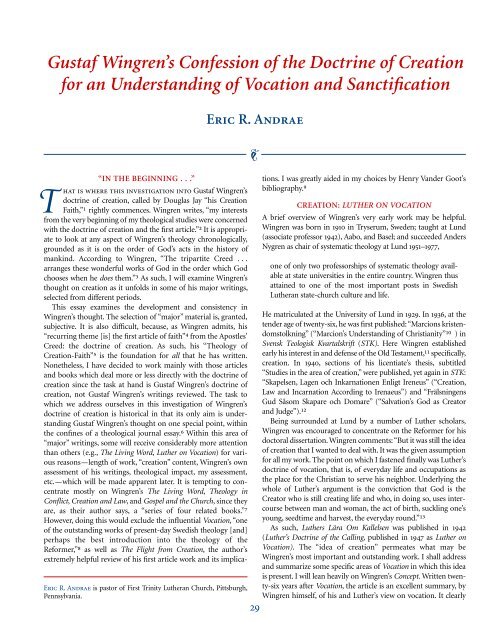
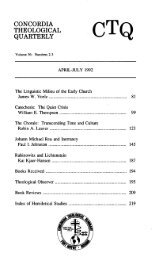
![VI nodaļa: CilvÄks â kas un kÄds viÅÅ¡ ir? [h]](https://img.yumpu.com/48350403/1/190x245/vi-nodaa-1-4-a-cilvaks-a-kas-un-kads-viaa-ir-h.jpg?quality=85)
